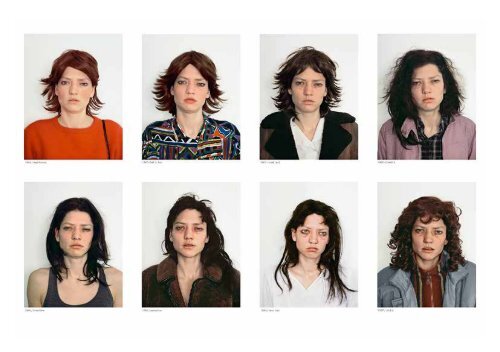PLAYING AND REALITY
FF_EJ_Major_RZ
FF_EJ_Major_RZ
You also want an ePaper? Increase the reach of your titles
YUMPU automatically turns print PDFs into web optimized ePapers that Google loves.
THE PERFORMED SELF<br />
In several series in this show the artist appears in the work including Marie Claire RIP (2004-2007), Shoulder to Shoulder<br />
(2009-2011) and her most recent works Every Day in November /When Nothing will Do (2015). You would not call any of these<br />
series self-portraits but more that the artist is the performer in the work. Once this is known by the viewer it of course<br />
significantly shifts the work’s meaning.<br />
Marie Claire RIP was made in response to police mugshots taken of an anonymous woman’s descent into drug addiction.<br />
These images were then published in a glossy women’s magazine as part of a campaign to educate women, one assumes,<br />
that drug addiction can impact negatively on their appearance. Major’s response to what she found a troubling exposé of<br />
an unnamed individual was to meticulously recreate the series using herself as the subject. Working in her studio she spent<br />
a lot of time both in the pre and post-production stages of the work. In Major’s version we see what we first read as a set<br />
of images showing a woman’s gradual loss of control, only to realise that the woman we see is an artist in total control of<br />
her look, masquerading as another.<br />
Shoulder to Shoulder grows from investigations into the photographic archives of the UK Suffragette movement. The women<br />
of this early political movement were keenly aware of the potential of photography as a means of media manipulation.<br />
Working in the early 1900s they were staging events that would often translate well into images that were then published<br />
in newspapers of the day. Harnessing the visual impact of their staged public acts they were photographed chaining<br />
themselves to railings outside public buildings; hurling themselves in front of horses in races and carrying out street<br />
demonstrations with banners. To get their message heard they were willing to shock polite society and the middle classes<br />
out of their complacency.<br />
5<br />
One act in particular, which in itself was not photographed at the time, involved a work of art and led to the temporary<br />
closure of the National Gallery in London. On Tuesday 14th March 1914 Mary Richardson attacked a painting: The Rokeby<br />
Venus by Diego Velázquez. In the middle of the day, whilst the work was guarded by two gallery staff, the diminutive figure<br />
of Richardson took a small axe to the painting. She smashed the protective glass and furiously slashed the canvas. When<br />
stopped she was taken to London’s Holloway Prison, advocating the case of the Suffragette movement as she went.<br />
E J Major’s work focuses on the moment before this act, where she stands in for Richardson and looks at the painting,<br />
wrestling with the decision of whether or not to commit the act. Talking about why she was drawn to the subject the artist<br />
states:


